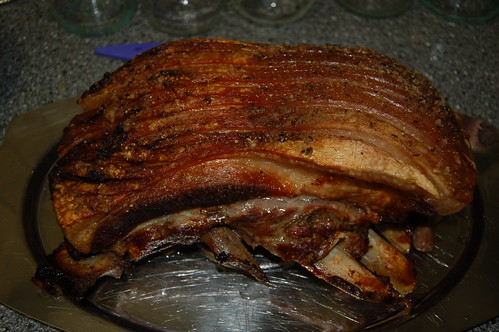As we now have taken delivery of lamb joints, chops and offal, in exchange for some of our Tamworth pork, I decided some rosemary jelly would be useful. I've just finished making it. 4 and a half jars of jelly are now sitting in the kitchen cooling. Most of the rosemary that went into it was dried. I found a jar of our dried rosemary in our spice cupboard so I added the whole of it. I also took a few fresh twigs from the rosemary bush in our back garden and added that as well. This all may appear to be overdosing on rosemary but my experience is that you need a good amount in the pan with the apples to make sure the flavour comes through.
All we have to do now is roast one of our legs of lamb. That, alas, has to wait for another week. Tomorrow I head to London for a few days so home cooking is on hold until I'm back.
We grow our own food in a suburban village in the North East of England. Follow us as we keep up the battle to be self-sufficient.
Wednesday 30 January 2013
Monday 28 January 2013
Roast belly pork
Sunday 27 January 2013
How to render pork fat - wartime style
People who eat significant quantities of processed foods end up consuming high levels of fat. Ready-made meals tend to have higher levels of fat as well. Since these meals are no longer part of our diet in our household and we eat little processed foods, the issue for us in trying to become self-sufficient is where to get sufficient fat from. The purchase of our Tamworth pig last October helped to provide us with a partial solution. As a traditional breed, Tamworths have a higher fat level than the tasteless, colourless pork sold in supermarkets nowadays which comes from mass-produced, modern breeds of pigs.
To work out how to extract the fat from the meat, I had to go back to a wartime Ministry of Food advice leaflet which explained how best to use the meagre fat ration. I had some bacon rind and some fat cut from the joint we roasted at Christmas. The rind itself was more skin than anything else. We cut it off before grilling the bacon as it is quite thick.
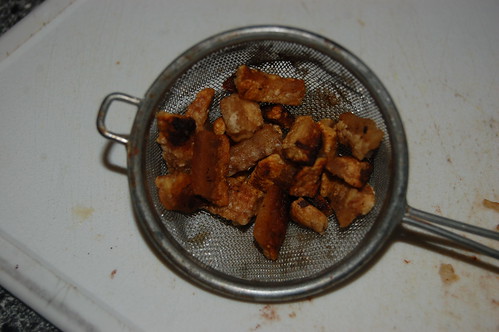
Using the advice from the wartime leaflet, I chopped the bacon and fried it (no fat was added) until all that was let was the liquid fat and crispy bits of rind/skin (see photo above). The fat was poured through a sieve into a bowl in which it could solidify. The crispy rind can be added to soups (or used as a nibble).

The fat from the joint was chopped up and then added to a pan. Enough water to cover the bottom of the pan was added. Bring the pan to the boil and then let it simmer. Stir regularly. You need to let all the water evaporate. The fat lumps soon start to release the liquid fat (see photo above) and reduced down to a fraction of their size. Once they are little more than dry fibrous lumps (see below) strain the fat through a sieve and leave to cool and solidify in a bowl. The lumps can, like the rind, be added to soups.

The final product should look something like this:

To work out how to extract the fat from the meat, I had to go back to a wartime Ministry of Food advice leaflet which explained how best to use the meagre fat ration. I had some bacon rind and some fat cut from the joint we roasted at Christmas. The rind itself was more skin than anything else. We cut it off before grilling the bacon as it is quite thick.

Using the advice from the wartime leaflet, I chopped the bacon and fried it (no fat was added) until all that was let was the liquid fat and crispy bits of rind/skin (see photo above). The fat was poured through a sieve into a bowl in which it could solidify. The crispy rind can be added to soups (or used as a nibble).

The fat from the joint was chopped up and then added to a pan. Enough water to cover the bottom of the pan was added. Bring the pan to the boil and then let it simmer. Stir regularly. You need to let all the water evaporate. The fat lumps soon start to release the liquid fat (see photo above) and reduced down to a fraction of their size. Once they are little more than dry fibrous lumps (see below) strain the fat through a sieve and leave to cool and solidify in a bowl. The lumps can, like the rind, be added to soups.

The final product should look something like this:

The thaw
At last, the thaw is happening. We had rain through the night and temperatures are warmer so the snow is melting rapidly. The hens are happy as there are now patches of bare ground which they can use for foraging for bug, especially under the hedgerows. The ducks on the other hand have rediscovered the pond. The ice has not yet melted there but meltwater from elsewhere has gathered on top of the pond ice, giving them about 5cm of water in which to paddle. They have been making the most of it after nearly two weeks of having to make do with paddling in the bowls we use to provide them with drinking water.
The problem now will be the wet ground. We will soon be back to mud. Lots of it.
The problem now will be the wet ground. We will soon be back to mud. Lots of it.
Saturday 26 January 2013
Hive check
We checked 11 bee hives today. Three belong to Bill Quay Community Farm where we do volunteer beekeeping. The other eight are our own. These were not full inspections. It is too cold for that. Instead, we simply took off the roof and cover board and checked the fondant that was added in the late autumn. All the hives still had fondant left in them and so did not need any extra adding. All the hives also had live bees in them so it seems they have all survived the winter so far.
Scotch eggs
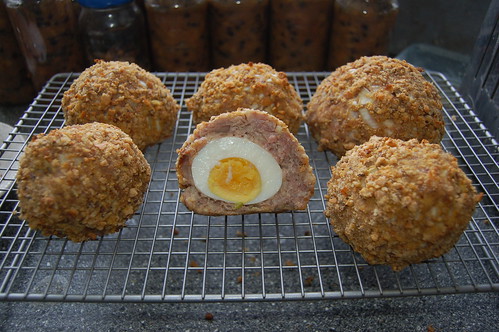
When we got the meat back from our Tamworth pig in October, nearly all of it went into the freezer. Only in the past week have I got round to using any of the sausage meat and the photo above shows the results. I made 6 scotch eggs. All the eggs were from our own hens and the onions I added to the sausage meat were grown on a neighbouring allotment. We traded eggs for them. Alas, I did add apple to the sausage meat but they came from the supermarket. We had an apple crop failure last year so we had no choice in the matter. We knew a few people who had managed to get fruit from their trees and had previously traded with them for apples. Alas, the apple barrel is now empty.
So, this was a mainly but not entirely self-sufficient meal.
Thursday 24 January 2013
Sean's Allotment episode 3
This is the latest from Sean and his allotment at Crystal Palace. Like me, he's suffering from the snow. There's a few seconds of my allotment in the video as well.
Wednesday 23 January 2013
The lamb has arrived

A friend of mine keeps sheep and when she found I had bought a pig, she became interested in a swap. So, this morning, I swapped with her 5 joints of pork, 1kg sausages, 1 kg bacon and 1kg sausage meat for 5 joints of lamb, a bag of chops, a bag of offal and 1kg of lap which I will put through my new sausage making machine.
I am rather looking forward to trying our first lamb joint but I think I will make some rosemary jelly to go with it.

Lamb chops.
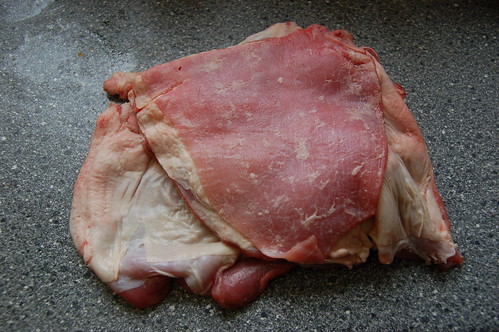
Lap - for turning into sausages.
Monday 21 January 2013
Protecting the greenhouse roof

With the weather as it is, I decided to remove the snow from the roof of the greenhouse this morning, rather than let it build up with the possible consequence that the glass will break under the weight. I will keep an eye on it over the next day or so but the snow was already building up again on the roof when I left the allotment a couple of hours ago.
Sunday 20 January 2013
Roasting a leg of our Tamworth pork
We recently had a leg of our Tamworth pork. I also had some apple syrup so I poured a jar of it over the leg, seasoned it and then roasted it - half an hour for each 450g plus a further half hour. We had some beautiful, crunchy cracking.
Saturday 19 January 2013
Stilton and onion flan

I've had a lump of stilton sitting in our cheese box since Christmas and neither of us were in a rush to use it. As food waste is treated as an unimaginable horror and sin in our household, the stilton clearly needed to be used up. So, last night, I made two stilton and onion flans. All the cheese was used to make them. 10 eggs went into each, helping to reduce our ever growing egg mountain. The two flans should do for four meals between the two of us.
Work grinds to a halt
We had over 5cm of snow overnight to add to what was already on the ground from earlier this week. We are not as badly affected as other parts of the country but no outdoor work can take place this weekend, other than feeding the poultry and cleaning out the hen and duck houses. I took the following photos on the allotment this morning.

The chicken run. Normally the hens wander far and free but today they are staying put in the chicken run, other than Bourbon, one of our ginger nut rangers, who wandered off to eat the duck food on the far side of the allotment:

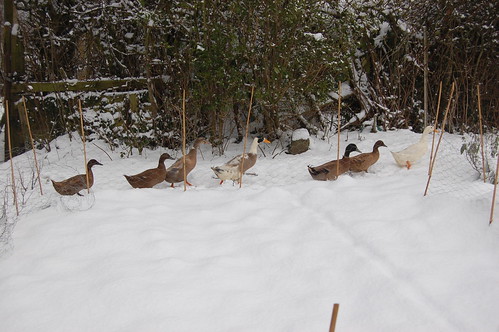
The ducks however are happy to wander.

Three of the beehives under snow.
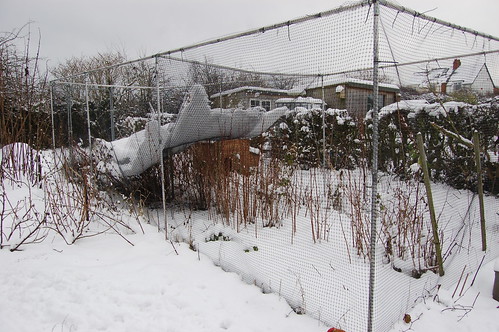
The roof of the fruit cage has collapsed.
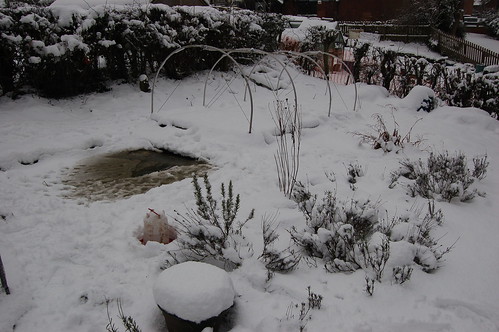
The pond and the polytunnel. The ice was 3cm thick on the pond.
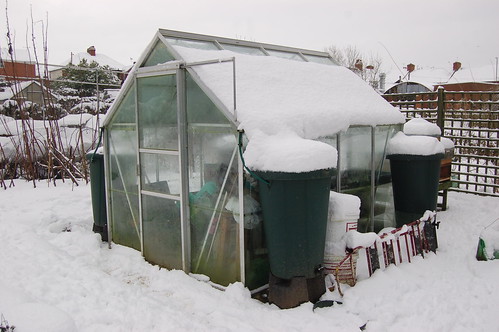
The greenhouse: remarkably nothing has frozen inside.

This is where we would have been working this weekend if there had been no snow. Our new shed is to be built on this plot and the rest will be used for growing potatoes. The ground needs to be prepared. We have lots of manure to go on it, but that too is hidden under snow.
And finally, teasles in the snow:
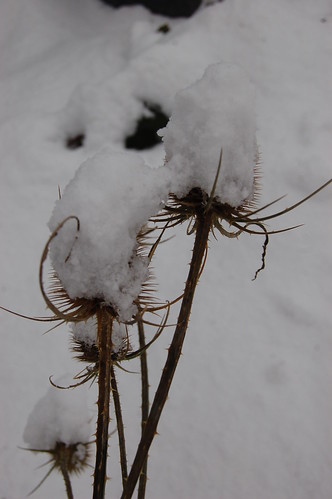

The chicken run. Normally the hens wander far and free but today they are staying put in the chicken run, other than Bourbon, one of our ginger nut rangers, who wandered off to eat the duck food on the far side of the allotment:


The ducks however are happy to wander.

Three of the beehives under snow.

The roof of the fruit cage has collapsed.

The pond and the polytunnel. The ice was 3cm thick on the pond.

The greenhouse: remarkably nothing has frozen inside.

This is where we would have been working this weekend if there had been no snow. Our new shed is to be built on this plot and the rest will be used for growing potatoes. The ground needs to be prepared. We have lots of manure to go on it, but that too is hidden under snow.
And finally, teasles in the snow:

Friday 18 January 2013
On the allotment 1 - mid January 2013
This is my new mini "radio" show from the allotment. I recorded it this morning after letting out the poultry (you can hear the ducks and hens in the background). It's an update on what we've been doing since the start of January.
Thursday 17 January 2013
Snow on the way
The weather forecast is grim. Snow is on its way. Wales and the west will get it first and we are due to follow tomorrow afternoon. We already have about 5cm on the ground from earlier this week but we are being warned that the forthcoming snowfall will be heavy, though for us, less heavy than South Wales. All this means that our plans to build our allotment shed this weekend are on hold. Ideally, I would like it built before the end of the month but that is now in doubt.
The ground is too frozen hard to dig and it's too early to be doing anything in the greenhouse (though I have a few onion sets growing there). I do however have some sprouting seeds to set away which I can do back home. This will be a useful fresh supplement to our diet.
The ground is too frozen hard to dig and it's too early to be doing anything in the greenhouse (though I have a few onion sets growing there). I do however have some sprouting seeds to set away which I can do back home. This will be a useful fresh supplement to our diet.
Sean's Allotment - episode 2
Sean Cameron is the producer and editor of The Horticultural Channel, the niche tv series in which I was a presenter in 2011. He continues to run the website (http://thehorticulturalchannel.info) which, amongst other people's work, carries some of my blog posts, photos and videos.
Sean is producing a weekly video from his allotment and this is edition 2 for this year. My hens and ducks have a cameo role towards the end.
Wednesday 16 January 2013
Taking shelter

I couldn't resist taking this photo today. Half my hens were perched in the shelter we built them last year to give them somewhere to stay dry during the constant rain. No rain today of course though it had snowed on Monday. The ground is frozen hard so the hens weren't going to have much luck free-ranging for bugs and grubs. At least on the perch they are off the cold ground.
So, a tip to any budding henkeepers: make sure your birds have shelter in rain and cold alike.
From duckling to duck

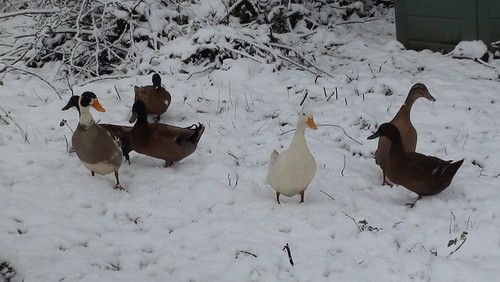
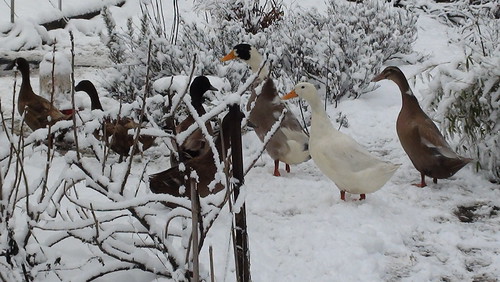
The ducklings we got in September are now fully grown. They aren't laying yet though the two point-of-lay khaki campbells we also got last year are producing eggs. One lays every day, the other on a more occasional basis.
The above photos were taken yesterday in the snow. Three of the ducklings have grown into ducks (none laying yet) but the magpie is a drake and, sadly for him, he will be appearing on our dinner table in the near future.
Bread making
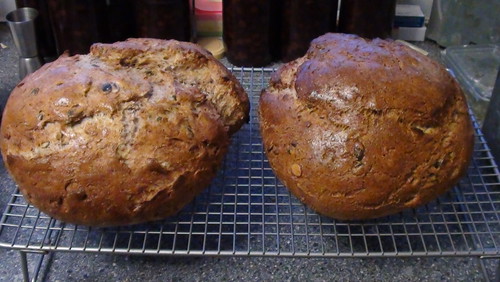
There are some foods that we will probably not be able to grow ourselves, or at least produce in sufficient quantities (unless we are able to get a modest amount of additional land). Wheat is one of these. So our flour supply has to be bought. Later this year we will be having a go at making flour from acorns and potatoes but at the moment, our source of flour is the supermarket.
We have, however, implemented a new rule. Buying bread, biscuits and cakes is no longer allowed. If we want a slice of bread, or a cake or biscuit with our tea, we have to make them ourselves. So, yesterday was a baking day for me. I didn't make any biscuits or cakes but I did make 2 large loaves of bread and 10 bread rolls. They are glazed with one of our own eggs. I'm rather pleased with the results.

Sunrise over the allotment
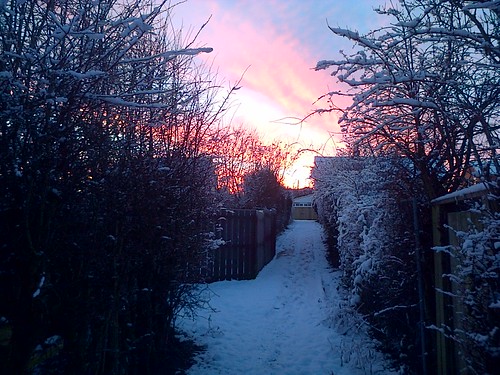
There was a lovely sunrise over the allotment this morning when I was there opening up the hen and duck houses. So I whipped out my blackberry and snapped this photo, taken of the path leading to the allotment gate. Still lots of snow on the ground, as you can see. The padlock on the gate was frozen solid and some of the hen house doors were frozen shut. Doing the usual morning tasks therefore took a bit longer than usual.
Tuesday 15 January 2013
How the hens and ducks coped with the snow
We had snow overnight so this morning I took a camera over to the allotment and filmed the reaction of the hens and ducks. The hens in particular were a bit confused. They didn't really know what to make of the snow. Normally they storm out of the hen houses when I opened them. Today they stuck their heads out, not sure what to do until they picked up the courage to go out. Meanwhile, the ducks loved it.
Sunday 13 January 2013
Mud!
2012 was the wettest year on record in England. As a result the ground is saturated. Since New Year, we have had a relatively dry period. There's been a bit of rain but not the downpours we had last year. Nevertheless, any rain now simply sits on the ground on the allotment. It cannot escape by draining into the soil. So even a shower leaves puddles behind it. The paths are churned up through constant use and I can't remember the last time I was able to walk about without wearing wellies.
The ducks and hens add to the mud problem. The ground in front of the duck house has been liquid mud since it was built in September. Our plan is to put in drainage there and along the main paths. Once the paths have their drainage dug, we will put down paving stones. Mud in the chicken run is not liquid. Instead it is thick and viscous. It's the sort of mud which, if deep emough, can suck your wellies off your feet!
My temporary solution is to blanket over the mud there with a layer of wood chippings. We have plenty of them. Last year, we had one of the old hedges cut back. It hadn't been touched for at least a decade. The hawthorn in particular had been allowed to run wild. The result of the cut back was a big pile of branches which were chipped and left in a large heap. I started today to spread it on the chicken run. There is still plenty to do. The heap of chippings is on the far side of the allotment site which therefore requires a walk of about 100 metres to get to it. This will be a job that will be completed later this week.
The hens however loved the chippings. Hours of endless fun followed as they kicked about the chippings looking for bugs to eat. Much better for them than mud.
The ducks and hens add to the mud problem. The ground in front of the duck house has been liquid mud since it was built in September. Our plan is to put in drainage there and along the main paths. Once the paths have their drainage dug, we will put down paving stones. Mud in the chicken run is not liquid. Instead it is thick and viscous. It's the sort of mud which, if deep emough, can suck your wellies off your feet!
My temporary solution is to blanket over the mud there with a layer of wood chippings. We have plenty of them. Last year, we had one of the old hedges cut back. It hadn't been touched for at least a decade. The hawthorn in particular had been allowed to run wild. The result of the cut back was a big pile of branches which were chipped and left in a large heap. I started today to spread it on the chicken run. There is still plenty to do. The heap of chippings is on the far side of the allotment site which therefore requires a walk of about 100 metres to get to it. This will be a job that will be completed later this week.
The hens however loved the chippings. Hours of endless fun followed as they kicked about the chippings looking for bugs to eat. Much better for them than mud.
Saturday 12 January 2013
Storage space
In setting off on our mission to become self-sufficient, we overlooked the issue of storage space. Now that we have developed our poultry and beekeeping mini ventures, the problem of adequate storage space has become more acute. Had we had decent sized crops last year to store through the winter (the rotten weather ensured we didn't), we would now be at crisis point. Even without the problem of storing our crops, we are currently climbing over sacks of hen food and boxes of empty jam jars just to get into the garage. A solution is, however, on its way.
Last week we bought a shed and it was delivered flatpack, along with a base, on Thursday. The base was painted with preservative today and we will take it over to the allotment tomorrow and assemble it. Hopefully within the next week or so, the shed will be assembled as well.
We have noticed that the lack of storage space is actually holding us back. 2013 is to be the big push to become as near self-sufficient as possible. Therefore, getting that shed constructed has to be a top priority for us.
Last week we bought a shed and it was delivered flatpack, along with a base, on Thursday. The base was painted with preservative today and we will take it over to the allotment tomorrow and assemble it. Hopefully within the next week or so, the shed will be assembled as well.
We have noticed that the lack of storage space is actually holding us back. 2013 is to be the big push to become as near self-sufficient as possible. Therefore, getting that shed constructed has to be a top priority for us.
Duck egg and broccoli flan
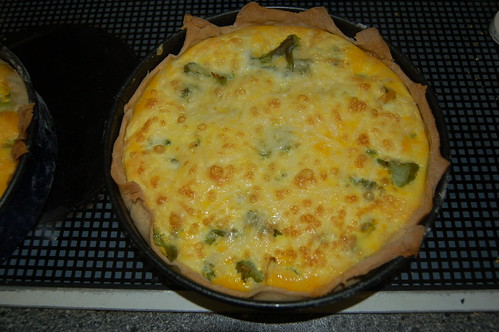
Our egg mountain continues to grow, despite my best efforts to supply family and friends. I decided on a radical solution to clearing the pile of duck eggs last night. I made a couple of duck egg and broccoli flans. My confession is that the broccoli was not grown by us and neither did we swap for it. With so many crops lost to the weather last year, we had to make a trip to the shops and buy some foods for the Christmas dinner to supplement what we had produced ourselves. The broccoli was not used up over Christmas and was unlikely to last much longer. To avoid food waste, it went into the flans.
I blanched the broccoli before adding it to the flan cases. I then added 8 beaten duck eggs to each flan. That got rid of the duck egg pile and will provide us with lunch for a few days.
Monday 7 January 2013
Egg numbers
We had 11 eggs today from our hens. I had to go back through our records to find that it was October when we last had that many eggs in one day. One of today's eggs was laid by one of our new hens though we are not sure which one in particular. Over the past few months the yield has been down as the hens have been moulting. Typically in December we were getting about 6 eggs a day. Since New Year's Day, yields have gone up.
The hens laid 2145 eggs in total in 2012. The ducks came in with a more modest 94 eggs though only 2 of them are laying and they only started in October. At some point soon, we will hatch some of the duck eggs in our new incubator, but that is for later in the year.
The hens laid 2145 eggs in total in 2012. The ducks came in with a more modest 94 eggs though only 2 of them are laying and they only started in October. At some point soon, we will hatch some of the duck eggs in our new incubator, but that is for later in the year.
Onion planting
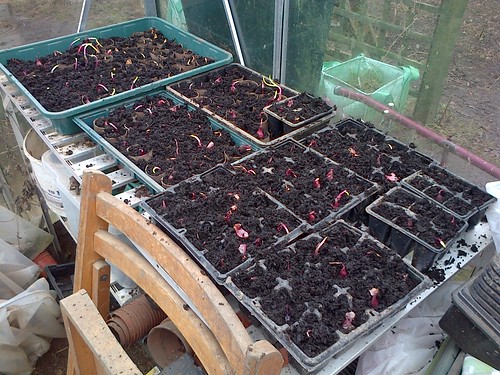
The heavy rains last autumn put an end to many of our attempts to plant winter crops. If we managed to get a few days without rain (there weren't many), we often found that the ground was so wet that it was impossible to plant anything. We managed to get a few cabbages in and half a bed of onion sets planted. Onions are one of our most important crops. They are used in a huge range of recipes and preserves. The miserable crop we got in 2012 has been supplemented with onions from other allotments. We traded eggs and jam for them.
Despite getting some of the onion sets planted, we had three quarters of them still to be used so over the weekend, instead of planting them outdoors, I decided to plant them in the greenhouse. Some went into recycled seed trays - ones in which we had previously bought seedlings, made up of lots of little compartments. Claire, one of my fellow presenters from the Horticultural Channel tv series, came up with the idea of using cut up toilet rolls as disposable plant pots. We liked the idea so much we have adopted it ourselves. No toilet roll holder is ever put into card recycling in our house now. For the past year, we have collected them and a few days ago I chopped them into smaller sections. Yesterday I filled them, and the recycled seed trays, with compost and put an onion set into each.
Once they have established themselves and the worst of the winter is behind us, we will plant them out in the allotment. The cardboard toilet roll holders will simply rot in the ground. We have two sorts of winter onions: electric red and radar.
Claire has her own YouTube channel: https://www.youtube.com/clairesallotment.

Sunday 6 January 2013
Three new hens
Yesterday we added three new hens to our flock: two are rhode rocks and one is a columbine.


They have settled in well and spent yesterday and today wandering about the allotment and eating. We have experienced no problems getting them to go into the henhouse in the evening. There have been a few scraps with some of the other hens but this always happens when new hens are added to an established flock. A new pecking order will establish itself.
We got three as that henhouse has a capacity for 10 but we had only seven living in it. Our other henhouse has no spare capacity. It brings our total of hens to 17.
Meanwhile, I snapped the shot below this afternoon. These are some of our older hens. They sometimes congregate next to the hedge and preen themselves. They particularly like it when the sun is on the spot. And over the past few days, sun is, remarkably, what we have been getting.



They have settled in well and spent yesterday and today wandering about the allotment and eating. We have experienced no problems getting them to go into the henhouse in the evening. There have been a few scraps with some of the other hens but this always happens when new hens are added to an established flock. A new pecking order will establish itself.
We got three as that henhouse has a capacity for 10 but we had only seven living in it. Our other henhouse has no spare capacity. It brings our total of hens to 17.
Meanwhile, I snapped the shot below this afternoon. These are some of our older hens. They sometimes congregate next to the hedge and preen themselves. They particularly like it when the sun is on the spot. And over the past few days, sun is, remarkably, what we have been getting.

Saturday 5 January 2013
How to make Quiche Lorraine

This is definitely not a recipe for the calorie-control minded person. We are building up a bit of an egg mountain at the moment so we are trying out lots of egg recipes. So last night I made 2 quiches, which also give us the chance to use up some of the bacon from our Tamworth pig.
To make the pastry, use 175g plain flour, 100g butter and the yolk of an egg with 4 tablespoons of water. Roll out the pastry and put it in a flan dish. Put a sheet of baking parchment over it and fill it with ceramic baking beans and bake for 15 minutes.
Chop 300g bacon amd lightly fry it for about 3-4 minutes. Then put it into the flan case (having of course removed the parchment and beans!). Chop 50g hard cheese (I used parmesan) and scatter it over the bacon.
Then beat together 200ml creme fraiche, 200ml double cream (I did warn about calories!) and 4 eggs along with the white from the egg which supplied the yolk for the pastry. Pour the mix into the flan dish over the bacon and cheese. Then grate some parmesan over the top and put into the oven for 25 minutes.
The quiche can be eaten hot or cold. We had ours cold with salad.
I am going to attempt a lower calorie version soon without the cream. I'll tell you how I get on.
Thursday 3 January 2013
A rain-free digging opportunity
What a useful way to start a new year: mild and rain free! Having today received the news that 2012 was the 2nd wettest year on record in the UK, I used the opportunity of a day of dry weather to begin preparing one of the large beds on our allotment for planting. A look around the rest of the allotment shows just how heavy the rain has been in recent months. Paths are still mud tracks and who beds have been flooded so often that nothing grows on them.
One of the biggest tasks coming up therefore is to put in drainage and pave some of the paths. We will dig some channels across the allotment and fill them with gravel. These will drain into the existing pond from which we will dig an overflow channel to a new pond to go into the bottom corner of the allotment.
The ground in the chicken run is also very muddy so we will be putting guttering onto the henhouses connected to waterbutts. This will help to stop rainwater leaking into the nest boxes therefore prolonging the life of the henhouses.
One of the biggest tasks coming up therefore is to put in drainage and pave some of the paths. We will dig some channels across the allotment and fill them with gravel. These will drain into the existing pond from which we will dig an overflow channel to a new pond to go into the bottom corner of the allotment.
The ground in the chicken run is also very muddy so we will be putting guttering onto the henhouses connected to waterbutts. This will help to stop rainwater leaking into the nest boxes therefore prolonging the life of the henhouses.
Subscribe to:
Posts (Atom)
